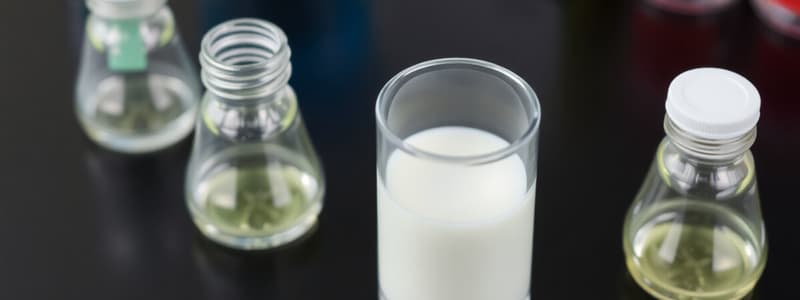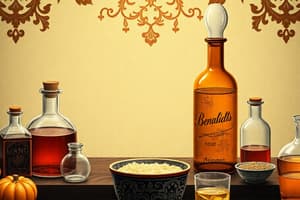Podcast
Questions and Answers
What color indicates the presence of starch when iodine solution is added?
What color indicates the presence of starch when iodine solution is added?
- Brick red
- Yellow-red
- Green
- Blue-black (correct)
What is the first step in testing for glucose using Benedict's solution?
What is the first step in testing for glucose using Benedict's solution?
- Heat the solution for 5 minutes
- Place food in a test tube (correct)
- Add iodine to the food
- Add ethanol to the food
Which reagent is used in the test for starch?
Which reagent is used in the test for starch?
- Biuret reagent
- Sodium hydroxide
- Iodine solution (correct)
- Benedict's solution
During the glucose test using Benedict's solution, what color indicates a positive result?
During the glucose test using Benedict's solution, what color indicates a positive result?
What must happen to Benedict's solution in order to test for glucose?
What must happen to Benedict's solution in order to test for glucose?
What color change indicates a positive result for the starch test?
What color change indicates a positive result for the starch test?
Which of the following is tested with Benedict's solution?
Which of the following is tested with Benedict's solution?
What should be done after adding iodine solution to the food during the starch test?
What should be done after adding iodine solution to the food during the starch test?
Why is it important to repeat the starch and glucose tests for different types of food?
Why is it important to repeat the starch and glucose tests for different types of food?
What color indicates a high concentration of glucose after using Benedict's solution?
What color indicates a high concentration of glucose after using Benedict's solution?
Which of the following is NOT part of the starch testing method?
Which of the following is NOT part of the starch testing method?
Which statement is true about the iodine test?
Which statement is true about the iodine test?
What is the purpose of using a results table in nutrient testing?
What is the purpose of using a results table in nutrient testing?
What is the first step in the Benedict's test for glucose?
What is the first step in the Benedict's test for glucose?
Which food item would most likely test positive for starch?
Which food item would most likely test positive for starch?
What safety precaution should be taken when using iodine solution?
What safety precaution should be taken when using iodine solution?
Which food tested positive for starch?
Which food tested positive for starch?
Which food contained no sugar as tested?
Which food contained no sugar as tested?
In the context of food testing, what does a '' indicate?
In the context of food testing, what does a '' indicate?
Given the results, which food could contain both starch and glucose?
Given the results, which food could contain both starch and glucose?
What conclusion can be drawn about Food C in terms of glucose?
What conclusion can be drawn about Food C in terms of glucose?
Which food can be ruled out as a source of starch without further testing?
Which food can be ruled out as a source of starch without further testing?
If a food tests positive for starch, what other polysaccharides may be present?
If a food tests positive for starch, what other polysaccharides may be present?
Based on the results, which of the following foods is likely the most carbohydrate-rich?
Based on the results, which of the following foods is likely the most carbohydrate-rich?
Flashcards
Iodine Test
Iodine Test
A test that identifies the presence of starch in a substance.
Benedict's Test
Benedict's Test
A chemical test used to detect the presence of simple sugars, like glucose, in a substance.
Ethanol Test
Ethanol Test
A test that identifies the presence of fats or lipids in a substance.
Biuret Test
Biuret Test
Signup and view all the flashcards
Iodine Solution
Iodine Solution
Signup and view all the flashcards
Benedict's Solution
Benedict's Solution
Signup and view all the flashcards
Ethanol
Ethanol
Signup and view all the flashcards
Biuret Reagent
Biuret Reagent
Signup and view all the flashcards
Food test results
Food test results
Signup and view all the flashcards
Positive food test
Positive food test
Signup and view all the flashcards
Negative food test
Negative food test
Signup and view all the flashcards
Adding rows or columns
Adding rows or columns
Signup and view all the flashcards
Adding labels or headings
Adding labels or headings
Signup and view all the flashcards
Evaluation
Evaluation
Signup and view all the flashcards
Conclusion
Conclusion
Signup and view all the flashcards
Hypothesis
Hypothesis
Signup and view all the flashcards
Proteins
Proteins
Signup and view all the flashcards
Carbohydrates
Carbohydrates
Signup and view all the flashcards
Lipids
Lipids
Signup and view all the flashcards
Solvent Extraction
Solvent Extraction
Signup and view all the flashcards
Food Tests
Food Tests
Signup and view all the flashcards
Study Notes
Required Practical 4: Food Tests
- Aim: To test foods for the presence of carbohydrates, lipids, and proteins using qualitative reagents.
- Carbohydrates:
- Sugars (e.g., glucose): Tested using Benedict's solution. A positive result is a change in colour from blue to brick-red/orange when heated.
- Starch: Tested using iodine solution. A positive result is a change in colour from orange/brown to dark blue/black.
- Lipids (fats): Tested using ethanol. A positive result is the formation of a cloudy/milky white emulsion when ethanol is mixed with the food sample and then poured into water.
- Proteins: Tested using Biuret reagent. A positive result is a change from pale blue to purple. Alternatively, use sodium hydroxide solution with copper sulfate.
- Safety: Follow safety guidelines, avoid eating food samples, use eye protection, be aware of chemical hazards like irritating sodium hydroxide and flammable ethanol.
- Equipment: Test tubes, test-tube rack, spotting tiles, beakers, water bath, pipettes, filter paper, sticky labels.
Aims and Learning Outcomes
- Aims: Identify the presence of carbohydrates, lipids, and proteins in food samples.
- Learning Outcomes:
- Describe the methods and positive results for each food test.
- Safely conduct the food tests in an organised manner
- Design a results table for recording food test results.
- Identify the constituents of foods using the test results.
Method
- Detailed methods for each food test provided in supplementary text, including steps for starch, sugar, lipids, and protein.. Be sure to accurately record observations.
Safety Precautions
- Food Allergies: Some people have food allergies. Avoid eating any of the food samples.
- Chemicals: Biuret reagent and sodium hydroxide are irritating. Wear eye protection
Results Table
- Design: Create a well-structured table to record observations about different food groups and reagents.
- Example Columns: Food tested, reagent used, initial colour, observed colour change, conclusion, presence/absence of each nutrient.
Questions and Analysis
- Analysis: Evaluate results, look for positive/negative results for each nutrient in different food samples.
- Example questions:
- Which food(s) tested positive for protein?
- Which foods tested negative for lipids?
- Do foods containing sugar also contain starch? Justify your answer.
Student Follow-up
- Student Results Table: Critically analyze the provided student results table.
- Improvements: Suggestion of improvements to the result table, such as clarity and complete observations.
Studying That Suits You
Use AI to generate personalized quizzes and flashcards to suit your learning preferences.





